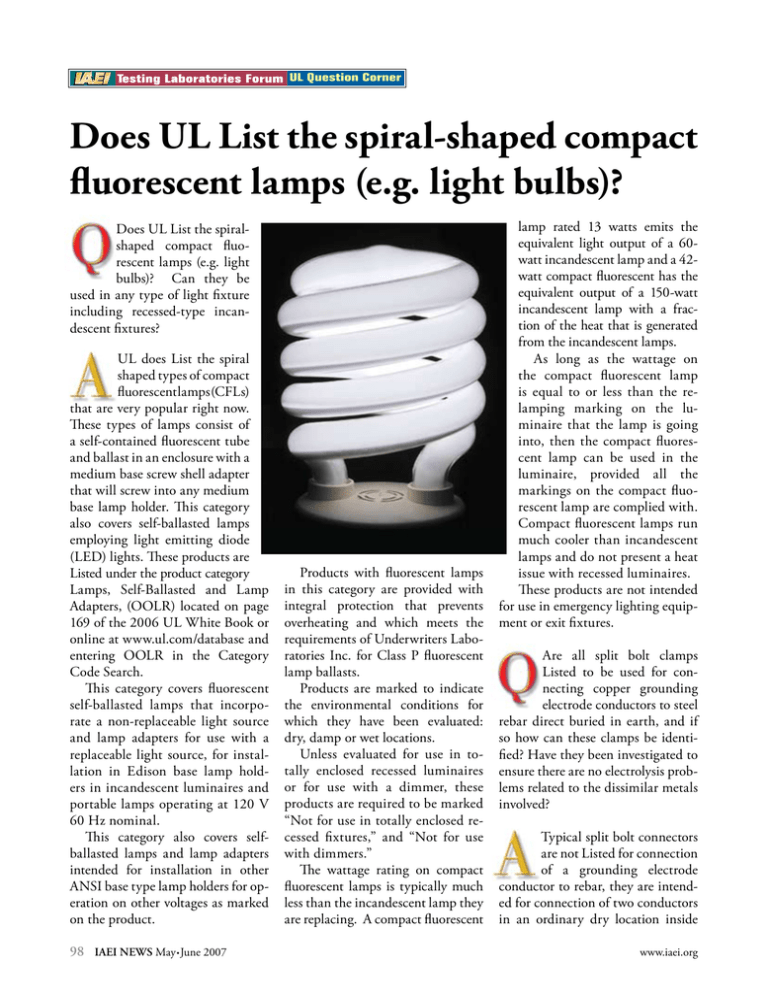Does UL List the spiral-shaped compact fluorescent lamps
advertisement

UL Question Corner Does UL List the spiral-shaped compact fluorescent lamps (e.g. light bulbs)? Does UL List the spiralshaped compact fluorescent lamps (e.g. light bulbs)? Can they be used in any type of light fixture including recessed-type incandescent fixtures? UL does List the spiral shaped types of compact fluorescent lamps (CFLs) that are very popular right now. These types of lamps consist of a self-contained fluorescent tube and ballast in an enclosure with a medium base screw shell adapter that will screw into any medium base lamp holder. This category also covers self-ballasted lamps employing light emitting diode (LED) lights. These products are Listed under the product category Lamps, Self-Ballasted and Lamp Adapters, (OOLR) located on page 169 of the 2006 UL White Book or online at www.ul.com/database and entering OOLR in the Category Code Search. This category covers fluorescent self-ballasted lamps that incorporate a non-replaceable light source and lamp adapters for use with a replaceable light source, for installation in Edison base lamp holders in incandescent luminaires and portable lamps operating at 120 V 60 Hz nominal. This category also covers selfballasted lamps and lamp adapters intended for installation in other ANSI base type lamp holders for operation on other voltages as marked on the product. Products with fluorescent lamps in this category are provided with integral protection that prevents overheating and which meets the requirements of Underwriters Laboratories Inc. for Class P fluorescent lamp ballasts. Products are marked to indicate the environmental conditions for which they have been evaluated: dry, damp or wet locations. Unless evaluated for use in totally enclosed recessed luminaires or for use with a dimmer, these products are required to be marked “Not for use in totally enclosed recessed fixtures,” and “Not for use with dimmers.” The wattage rating on compact fluorescent lamps is typically much less than the incandescent lamp they are replacing. A compact fluorescent 98 IAEI NEWS May.June 2007 lamp rated 13 watts emits the equivalent light output of a 60watt incandescent lamp and a 42watt compact fluorescent has the equivalent output of a 150-watt incandescent lamp with a fraction of the heat that is generated from the incandescent lamps. As long as the wattage on the compact fluorescent lamp is equal to or less than the relamping marking on the luminaire that the lamp is going into, then the compact fluorescent lamp can be used in the luminaire, provided all the markings on the compact fluorescent lamp are complied with. Compact fluorescent lamps run much cooler than incandescent lamps and do not present a heat issue with recessed luminaires. These products are not intended for use in emergency lighting equipment or exit fixtures. Are all split bolt clamps Listed to be used for connecting copper grounding electrode conductors to steel rebar direct buried in earth, and if so how can these clamps be identified? Have they been investigated to ensure there are no electrolysis problems related to the dissimilar metals involved? Typical split bolt connectors are not Listed for connection of a grounding electrode conductor to rebar, they are intended for connection of two conductors in an ordinary dry location inside www.iaei.org UL Question Corner an enclosure and are Listed under the category Wire Connectors, (ZMVV) located on page 307 in the 2006 UL White book or online at www.ul.com/database and entering ZMVV at the Category Code Search. These type of split bolts connectors are not intended to be used for grounding applications to connect a grounding electrode conductor to rebar or any other component of the grounding electrode system. The Listing Mark on the connector or packaging would identify it as a wire connector. Split bolt connectors evaluated for grounding applications as well as other types of grounding clamps are Listed under the product category Grounding and Bonding Equipment, (KDER) located on page 122 in the 2006 UL White Book or online at www.ul.com/database and entering KDER at the Category Code Search. As part of the Listing evaluation of a grounding or bonding device, they are required to be constructed of a metal or metals that, when the device is installed under conditions of actual service and exposed to moisture, will not be likely to be adversely affected by electrolysis. Clamps Listed under Grounding and Bonding Equipment (KDER) are evaluated for compliance with The Standard for Grounding and Bonding Equipment, UL 467. A grounding or bonding device marked as acceptable for burial in earth or embedment in concrete shall be provided with all screws necessary for assembly or connection of the device, and shall be constructed of copper or a copper alloy containing not less than 80 percent copper, or stainless steel. Grounding-type split bolt clamps or connectors Listed for use with rebar will be marked on the connector or a tag on the connector identifying the size range of the rebar and conductor size the device was Listed for use with. In addition, connectors Listed for direct burial in earth or encased in concrete are marked “DB” or “Dir Bur.” The Listing mark on the product, or on a product tag or product container will identify the product as grounding and bonding equipment. The “UL Question Corner” answers questions of general interest that are sent in from authorized government inspectors that we believe will have interest for many inspectors. Please send us questions you may have that are general interest, and we will have UL engineers answer them in a future issue. If space does not permit answering all questions, we’ll see that you get an answer by letter. Send your questions to: iaei@iaei.org, or UL Question Corner, IAEI News PO Box 830848 Richardson, TX 75083 ALLIED MOULDED HALF PAGE AD PU May/June 2006 Page 39 www.iaei.org May.June 2007 IAEI NEWS 99

